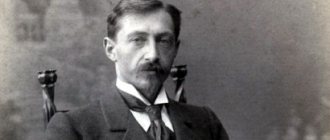“What is interesting about N. M. Karamzin’s story “Poor Liza””
N. M. Karamzin is one of the most prominent representatives of Russian sentimentalism.
All his works are imbued with deep humanity and humanism. The subjects depicted in them are the emotional experiences of the heroes, their inner world, the struggle of passions and the development of relationships. The story “Poor Liza” is rightly considered the best work of N. M. Karamzin. It touches on two main problems, the disclosure of which requires a deep analysis and understanding of Russian reality in the 18th century. and the essence of human nature in general. Most contemporaries were delighted with “Poor Lisa.” They absolutely correctly understood the idea of the author, who simultaneously analyzed the essence of human passions, relationships and the harsh Russian reality. The most interesting is the love line of this work. Never before in Russian literature has love been described so vividly and so beautifully. Analysis of the characters' feelings and experiences absorbs the author. Lisa and Erast are representatives of different social classes: she is from a poor family, he is a rich nobleman. The image of Lisa is beautiful and romantic, she captivates with her spiritual purity and nobility. The girl was born into a family of honest and hardworking people, and she herself works tirelessly. Lisa speaks of her mother with deep respect and love and is grateful for the fact that she gave her life. In addition, the girl is extremely honest and believes that money can only be taken for work. She refuses to take a ruble from Erast for flowers, because they are not that expensive. Lisa is an example of spiritual purity and purity. Her chosen one, Erast, is presented in a completely different light. The author gives him the following characteristics: “. This Erast was a rather rich nobleman, with a fair mind and a kind heart, but weak and flighty, he led an absent-minded life, thought only about his own pleasure, looked for it in secular amusements, but often did not find it.” Erast is the complete opposite of Lisa; he does not have her integrity, her purity. He is corrupted by secular life, has already learned a lot, but is also disappointed. Lisa captivates Erast with her beauty and innocence. He admires her, even tries to fight the desire to be in a closer relationship with her. “I will live with Liza like brother and sister,” he thought, “I will not use her love for evil and I will always be happy!” But Erast’s good intentions are not destined to come true. Young people succumb to passion, and from that moment their relationships change. Lisa is afraid of punishment for her action, she is afraid of the thunder: “I’m afraid that the thunder will kill me like a criminal!” She is happy and deeply unhappy at the same time. The author shows his attitude towards love and says that “the fulfillment of all desires is the most dangerous temptation of love.” Nevertheless, he still does not condemn his heroine and still admires her, because nothing can discredit a beautiful, pure soul. In the end, Erast decides to leave Lisa. First, he goes to war, loses his entire fortune at cards, returns and marries a rich widow for money. Erast is trying to pay off Lisa with money. The girl experiences a strong emotional shock and, unable to bear it, throws herself into the pond. Her death is tragic and terrible, the author speaks about it with deep sorrow. At first glance, Erast appears to be an insidious seducer, but in reality this is not entirely true. It is not without reason that, in order to somehow justify the hero, Karamzin says that Erast was unhappy all his life and considered himself a murderer. In the story “Poor Liza,” Karamzin touched on very serious and important problems, but did not indicate the way to resolve them, and he did not set such a goal for himself. The imperfection of the social structure and human nature is a real fact, and it is pointless to reproach anyone for this. P. Berkov writes the following about this: “Most likely the idea of the story is that the structure of the world (not modern, but in general!) is such that the beautiful and just cannot always be realized: some can be happy. other. can not".
www.allsoch.ru
Literature lesson summary “Poor Lisa” as a work of sentimentalism”
Lesson notes on literature in 9th grade.
Lesson topic:
"Poor Liza" as a work of sentimentalism.
The purpose of the lesson:
familiarize yourself with the text of the work and, on the basis of this, generalize and systematize students’ knowledge on content, themes, characteristics of the characters, moral issues, and the position of the author of the story “Poor Liza” by N.M. Karamzin.
Tasks:
educational:
— to develop the ability to see the distinctive features of sentimentalism in literature;
developing:
- promote the development of critical thinking, interest in the literature of sentimentalism, develop interest in the origins of Russian literature;
- promote the development of the ability to reason about the problem posed, based on the material of the story, on personal experience;
- promote the development of the skill of constructing coherent statements in oral and written form.
educational:
— contribute to the education of a spiritually developed personality, the formation of a humanistic worldview;
- cultivate an attentive attitude to people’s feelings;
- cultivate a sense of responsibility for one’s actions.
Lesson type:
A lesson in learning new material.
Equipment:
portrait of N.M. Karamzin, illustrations for the story “Poor Lisa”, literary text of the story “Poor Lisa”, textbook on literature grade 9 edited by V.Ya. Korovina, handouts for students’ independent work, illustration by O. A. Kiprensky “Poor Lisa.”
Epigraph:
Only a lover has
right to the title of a person.
Alexander Blok.
During the classes:
1.
Organizational stage (3 min.)
2.
Repetition of previously studied material (7 min.)
At the last lesson, we talked about the biography of the wonderful Russian writer N.M. Karamzin. Let's try to remember what kind of person he was during his lifetime, what were his hobbies?
In addition, we worked with such a concept as sentimentalism. What do we know about it, what is its difference from classicism, for example, the works of M.V. Lomonosov and G.R. Derzhavin? We also began to get acquainted with N.M. Karamzin’s story “Poor Liza”. Let's try to remember what this work is dedicated to?
3.
The teacher's word
We again turn to a problem that has always worried and will worry humanity: the mind and heart. We know that sentimentalism affirms the cult of feeling. But it turns out that you still can’t do without reason. And today you have to do serious but exciting work: to reveal the problems of the story “Poor Liza”, to consider the system of images in the work.
4.
Commented reading of the text of the work according to the textbook by V. Ya Korovina (25 min).
5.
Work with the illustration by O. A. Kiprensky “Poor Lisa” (7 min.)
How does Lisa appear in this picture? How does this picture make you feel? We see a girl who is yearning and sad. She is young and pretty. There is a plea in her eyes. She looks at the person she is about to part with. In her hands she holds a red flower, symbolizing love. Kiprensky simply could not portray the peasant woman in any other way. Her feelings don't matter to anyone. Her love simply has no future. Social inequality was to blame.
6.
Discussion of the problems of the story “Poor Liza” (15 min)
—
Modern scientist Vladimir Branislavovich Muravyov is convinced that the story “Poor Liza” “has not known oblivion or loss of reader love in two centuries.” This means that even now the story is read with interest. Have your say as readers too. Are you interested in this story? If yes, then with what? What attracts you to her? Is it true, in your opinion? What do you think is true and what is not? Try to understand your feelings and experiences while reading and explain them.
— Now we will divide into three groups, each of which will try to answer a number of questions regarding this story.
Group No. 1
1. The problem of education in the story. How is the image of Lisa drawn in the work? What is the character of the heroine? Why is she like this? What is your version of the meaning of the title of the work?
2. The problem of education in the story. How is the image of Erast presented in the work? Explain the reasons and motives of his actions, features of behavior.
Group No. 2
1. The problem of love in the story. Is the love that binds “fathers” different? "children"? Are the feelings that Lisa experiences for Erast and Erast for Lisa the same? How do the characters behave towards each other? Is love possible between a master and a peasant woman?
2. Explore the composition of the work. Determine the nature of the landscapes and their role in the story. Expand the role of the framing: the picture of Moscow with monasteries, temples at the beginning of the work and the last four paragraphs of the story.
Group No. 3
1. How do we see the image of the author in the work? How does he evaluate the actions and characters of his heroes? How does he perceive what is happening, what happened? What ideas does he want to establish in the work? Did he manage to translate his idea into the story? How he does it?
2. What prompted Lisa to commit suicide? What is your attitude towards her action? Could the shame be avoided otherwise? Express your opinion on the ending of the story.
- Issues for discussion:
— From whose perspective is the story told?
?
(On behalf of the narrator.)
- Is this the only role of the narrator? Prove the presence of a narrator from the text .
(The narrator is mentally involved in the relationships of the characters. We see in him a noble, humane person, vulnerable, acutely aware of the misfortune of others. The narrator can be sad, joyful, angry).
— What kind of main character do we see in the parental family? What could her father and mother teach her? What did Lisa's mother call her?
— What epithets does the author give to his heroine? (according to the text)
— Let’s trace the nature of the characters’ feelings, how they develop, and what they lead to. First of all, the feelings of the main character of the story - Lisa. What was the flashing feeling for Lisa?
(You can identify internal experiences that speak of Lisa’s love: embarrassment, excitement, sadness, insane joy, happiness, anxiety, melancholy, fear, despair, shock. Lisa’s feelings are distinguished by their depth, constancy, selflessness. She understands perfectly well that she is not destined to be Erast's wife, and even speaks about this twice in the story: "Mother! Mother! How can this happen? He is a gentleman; and among peasants...", "However, you cannot be my husband!.. I am a peasant..." But love turns out to be stronger than reason Erast's confession filled Lisa's heart with a “pure and at the same time passionate feeling" that she cannot and does not want to hide. The heroine forgot about everything and gave all of herself to her beloved).
— How does the author convey this or that state of Lisa?
(
Liza “blushed even more and, casting her eyes to the ground, said...”, “sang mournful songs in a quiet voice”, “followed him with her eyes”, “all the veins in her began to beat”, “got up, wanted to go, but couldn’t” and etc. We conclude that the external manifestations of experiences precisely found by the writer allow us to understand what is happening in the heroine’s soul. Lisa’s soul is distinguished by its richness and depth. “And peasant women know how to love!”)
- Why do you think Lisa expresses herself so correctly and poetic language?
(Karamzin in the story resolved the issue of the extra-class value of a person, he wanted to reveal the beauty and nobility of the feelings of his heroine, that’s why such language.)
— What does the reader learn about Erast before meeting Lisa?
—What opinion do you have about him? What was the flaring feeling for Erast, who had already tasted “secular fun”?
(The selfless character of the peasant woman is contrasted with the character of a kind but spoiled master, unable to think about the consequences of his actions. Lisa attracted him primarily with her appearance. The intention to seduce the gullible girl was not part of his plans: “It seemed to him that he found in Lisa what the heart has been searching for a long time." Let us note that such an effect of female beauty on the male soul is a constant motif of sentimental literature. Initially, he thought “about pure joys”, intended to “live with Lisa, like a brother and sister.” The author’s irony is felt. But still Erast Karamzin is not depicted as a treacherous deceiver-seducer. According to the author, “a fairly rich nobleman” with a “naturally good” heart, but “weak and flighty, he led an absent-minded life, thought only about his own pleasure...” His betrayal is unintentional, but more insidious).
- So, love became a test for the hero?
(He did not know his character well, he overestimated his moral strength. Erast’s sentimental ideals were formed under the influence of books: “He read novels, idylls; he had a fairly vivid imagination and often moved mentally to those times (former or not), in which, if you believe poets, all the people walked carelessly through the meadows <...> and spent all their days in happy idleness." Soon, according to Karamzin, he "could no longer be satisfied <...> with just pure embraces. He wanted more, more and, finally, I couldn't wish for anything." Satiety sets in and the desire to free oneself from the boring connection sets in. There is no depth in his feeling, it is selfish).
— In “Poor Lisa,” the theme of money occupies a significant place. How does everything related to money illuminate human relationships?
(The leitmotif of money accompanies the image of the nobleman Erast, and not poor Lisa. The heroine has no selfish thoughts. During one of the dates, Lisa tells Erast that the son of a rich peasant from a neighboring village is wooing her and that her mother really wants this marriage. “And do you agree?" - Erast is wary. "Cruel! Can you ask about this?" - Liza reproaches him. Having broken the girl's heart, Erast wants to pay her off: "Here are a hundred rubles - take them (he put the money in her pocket) - let me I need to kiss you one last time and go home." He marries a rich widow to improve his affairs.)
- What can you call Erast at this moment? What is he like?
- How to evaluate Lisa’s action? Isn’t she “paying off” her mother with these hundred rubles?
(In sentimental literature, money has always evoked a condemnatory attitude towards oneself. Sincere, real help should be expressed in actions, in direct participation in the fate of people. Money creates only the appearance of participation and often serves as a cover for impure intentions. “I forget the person in Erast - I’m ready to curse him - but my tongue does not move - I look at the sky and a tear rolls down my face").
— How is the author’s attitude towards the hero manifested here?
— How is the theme of love between the peasant woman Lisa and the nobleman Erast resolved??
(A person in the literature of sentimentalism is devoid of fighting spirit, does not fight for his feelings, submitting to circumstances. For Lisa, the loss of Erast is tantamount to the loss of life. Further existence becomes meaningless, and she commits suicide).
— How do you think the author feels about the heroine’s suicide?
— What do we learn about Erast from the ending of the story? Has the soul been cleansed?
(Yes, he realized his mistakes, “could not console himself,” he cruelly reproaches himself, goes to Lisa’s grave. Karamzin talks about the meeting and reconciliation of their souls in another world).
— We conclude: using the example of Erast’s life, Karamzin shows what a big role the feeling of love plays in the formation of the human personality, but also warns about the need for reason in love.
— In whose mouth does the writer put these reflections?
(
Mothers of Lisa and the Narrator. They are mature, wise people, they know life better, they understand that a person builds his happiness on the harmony of feelings and reason...)
- How to understand the final phrase of the story?
— To achieve maximum verisimilitude, Karamzin connected the plot of his story with specific places of the then Moscow region. Lisa's house is located on the banks of the Moscow River, not far from the Simonov Monastery. The meetings between Erast and Liza took place near Simonov Pond, which after Karamzin’s story received the name Liza Pond. In the spirit of sentimentalism, the author combines a description of nature with a depiction of human thoughts and moods.
— Let's turn to the landscape, how is it connected to other aspects of the story?
(The guys analyze landscape sketches, give interpretations to the symbols of spring, lily of the valley, fog, autumn; note the connection of nature with Lisa (“The sad turtle dove combined her plaintive voice with her lamentations” and other examples) and the absence of such a connection with Erast. They talk about light and darkness in the story.The author, in their opinion, endows nature with reason.
—What is the meaning of the title?
— What kind of “good feelings” do Karamzin’s story foster in readers, in your opinion? Can today's young people learn moral lessons from it? If yes, which ones?
(Karamzin teaches to value a person not by class, but for spiritual wealth, manifested in love. Teaches responsibility for one’s actions).
7.
Independent work based on N.M. Karamzin’s story “Poor Liza” (20 min)
8.
1. Find words and expressions that characterize the heroes, fill out the table.
| Lisa | Erast |
9.
2. We determine from the text of the story what values are significant in each of the characters’ worlds.
| “Lisa’s World” | “The World of Erast” |
3.Image of Lisa.
| Question | Answer |
| 1.Tell me about Lisa. What kind of main character do we see in the parental family? What did her parents teach her? | |
| 2.What epithets does the author give to his heroine? | |
| 3.What is the relationship between mother and daughter? 4.What does Lisa see as her duty to her mother? | |
| 5.What can you say about Lisa’s mother? 6.How do you think she raised her daughter? 7.For what purpose is the image of Lisa’s mother introduced into the story? |
10.
4.Image of Erast.
| Question | Answer |
| 1.Tell me about Erast. How did he appear to you, to Lisa’s mother? In your opinion, is Erast a positive or negative hero? | |
| 2. What do we learn about Erast before meeting Lisa? | |
| 3.Under what circumstances did the meeting between Erast and Lisa take place? | |
| 4. How does Karamzin show the development of feelings between young people? | |
| 5. What did the flaring up feeling mean for Lisa and for Erast, who had already tasted social fun? | |
| 7. The feelings of the heroes, their state are closely related to nature. Prove that descriptions of nature “prepare” heroes and readers, “tune” them to certain events. |
5. Relationships of heroes.
| Question | Answer |
| 1. Why do you think Erast did not want Lisa’s mother to know about their meetings? | |
| 2.What does the author of Erast warn about? | |
| 3. When and why did Erast’s attitude towards Lisa change dramatically? | |
| 4.What is the author’s attitude towards Lisa? | |
| 5. In what words does the author evaluate the hero’s actions? Does he condemn Erast? | |
| 8. How did the characters’ relationship end? | |
| 9.What is the fate of the heroes? Was Erast happy? |
11.
8. Summing up the lesson.
Answers and explanations
The meaning and problems in this story - Poor Lisa! it's simple. 1 our Russian reality. Although the hero Erast loved his mother, in his own way, he seems kind, but he is very flighty - he played cards a lot, cheated, lost. And Lisa was from a poor family, very honest, there is an example that she does not even take a ruble from the owner, she is pure, she is also trusting in soul, they are both from different social strata. He is rich, she is poor, and the romance that began between them will not lead to anything good, especially for Lisa.
Family relationships are built on love, compassion, empathy, empathy, and trust. And these qualities are brought up in a person by the family. Therefore, the family is a school of sensitivity. This is confirmed by the touching affection of Liza’s parents to each other: “Oh, we could never look at each other enough - until the very hour when cruel death crushed his legs. He died in my arms.” Timeless fidelity was carried through life by Liza’s mother to her husband: “In the next world, dear Liza, in the next world I will stop crying... I will surely be cheerful when I see your father.” It is in the family that Lisa learns to courageously bear her difficult cross: “... the poor widow... became weaker day by day and could not work at all. Liza alone, who remained after her father for 15 years, Liza alone, not sparing her youth, not sparing her rare beauty, worked day and night. The family instills in Lisa the greatest human virtue—sacrifice for the sake of her neighbor. How simply the 15th girl explains to her mother her concern for her: “...you fed me with your breasts and followed me when I was a child; now it’s my turn to follow you.” Using a complex sentence with a subordinate reason, the author creates a unique “formula” for the well-being of the family: hard work, diligence, loyalty, obedience, love, mercy, trust and mutual understanding.
znanija.com
Arguments for essay 15.3 from the story “Poor Lisa” (OGE in Russian)
For argumentative essay 15.3, qualitative arguments are especially important. It is best to find examples from literature that is familiar to all 9th grade students. The story by N.M. is ideal. Karamzin “Poor Liza”, where many topics are revealed on the OGE in the Russian language.
- Inner world
. In a conversation with her beloved, Lisa reminded him that they could not get married: a peasant woman was not a match for the master. But Erast objected to her, because what was most important to him was the pure and innocent soul of the girl, and not her social status. It was the naturalness and richness of the heroine’s inner world that Erast liked so much. For their sake, he was ready to go against the laws of the world and marry a peasant woman. But as soon as Lisa fell in his eyes, he stopped feeling attracted to her. Thus, many people value a person's inner wealth more than his material values. - Conscience
. When Erast announced his engagement to Lisa and gave her money, she headed home and stopped by a deep pond. The heroine could no longer live after the betrayal of her beloved and took her own life. They couldn't save her. The mother also died from the news she received. Having learned about this drama, Erast began to blame himself for everything and lived his whole life under the pressure of his conscience. This means that conscience is an internal judge that punishes us for bad deeds. - Love
. The heroine fell in love with Erast and sacrificed everything she had for him. She refused to marry a wealthy peasant and dedicated her virgin purity to her chosen one before the wedding. The girl trusted him beyond measure, therefore, having lost her beloved, she lost the meaning of life. Thus, true love always becomes a guiding star for a person, without which he cannot see his way. - Repentance
. The main character's suicide is a direct consequence of her repentance. In the old days, a relationship with a man before marriage was considered shameful for a girl. In the peasant environment, this sin was especially shameful and shameful, so Lisa, realizing the depravity of her act, was unable to live. Erast could not become her husband, being the fiancé of another girl, and this fact crossed out the heroine’s future. From now on, she was a fallen woman who had no moral right to bear an honest name. Her repentance was sincere, because in atonement for sin, she sacrificed the most precious thing - her life. - Kindness
. The main character was distinguished by kindness, which found expression in real deeds, and not in pompous words. So, Lisa worked alone for the whole family to provide her sick mother with everything she needed. Even before committing suicide, she thought about her and sent money so that her mother would not need anything. The care and affection of a daughter towards her mother is the best proof of her selfless kindness. - Mother's love.
Lisa's mother, an old and sick peasant woman, loved her daughter very much and lived thinking only about her happiness. It was the meaning of her life. Therefore, after the news of her daughter’s death, she died of a stroke. The mother's heart could not stand this grief. It survived the death of her husband, but did not survive the death of her child. This fact speaks of the phenomenal power of love connecting a woman and her fetus. - Happiness.
Each of us sees happiness in our own way. Lisa saw him in love and the joy of life with his loved one. Her mother lived in hope for her daughter’s well-being and happiness. But Erast saw him in luxury and idleness and was deceived: his fate was tragic, because the guilt for Lisa’s death followed him even in the richly decorated living room. Therefore, it is very important to correctly identify what will become an inexhaustible source of joy and inspiration. - Life values
. The real value of a person is love. That is why the main character of the story “Poor Lisa” could not live without her. But money and position in society, which people often consider their most important asset, did not help her chosen one find his place in the world and feel the joy of life. Without love and with a feeling of repentance, he vegetated and did not live, although he had everything he needed for comfort and idleness. This means that real life values are spiritual and moral wealth, and not material excesses. - Moral choice
. Not everyone can adequately pass the test that is determined by the need for moral choice. So, Erast could not refuse wealth and choose not him, but his moral duty to the girl whom he seduced. So he tried to bribe her and his conscience with generous gifts, but still did not drown out the voice of his conscience, announcing the wrong choice.
Erast's betrayal
But Erast turned out to be a scoundrel, abandoning Lisa. The heroine only accidentally finds out about his betrayal. Having gone to Moscow to buy rose water, she accidentally runs into his carriage on the street. Lisa rushes towards her, but the carriage passes her and stops in the courtyard of a large house. The heroine runs up and hugs her lover, but he calmly announces that he is getting married (as it turns out later, he married a rich widow to improve his situation, since he lost almost all his money at cards during the campaign) and asks to leave him alone, trying pay off Lisa with money. And Karamzin does not justify his hero at all, but openly condemns him. Erast will be punished for his betrayal: he is destined to be unhappy for the rest of his life and blame himself for Lisa’s death. At the end of the work he dies.
Continuing to analyze the image of Lisa in the story “Poor Liza” by Karamzin, we must note one more important detail - she loved Erast, but at the same time did not forget about her mother, and it was caring for her that stopped Lisa from trying to go to war for her lover . Although the heroine was very worried about Erast, she was afraid that he would be killed in the war. After all, Lisa couldn’t even write messages to her lover, because she simply didn’t know how to do it.
Essay on the topic of betrayal, poor Lisa
11 options
Russian literature is rich in lyrical and sentimental works.
One of these works is the story “Poor Liza,” which was written in 1792 by the wonderful writer Karamzin. This story awakens many feelings, and also makes the reader remember humanity and respect for people. The work describes the tragedy, and everything written is perceived by the reader as a real story. This is due to the fact that the narrator was familiar with the hero, who showed him Lisa’s grave. Many people were interested in this story thanks to the images of people that the author created. The characters are filled with many feelings. Some people are good, some do evil, and some make many mistakes and agree with them. The author describes the landscapes and beauty of nature very beautifully. Beautiful and touching words indicate that Karamzin had a very deep soul. The poet compares the urban area and the countryside. Wonderfully describes summer in Moscow, and also masterfully transitions to the autumn season and thereby prepares the reader for more disturbing feelings. The central characters of the story are Lisa and Erast. The author described Erast as a wealthy man who has kindness and an open heart, but on the other hand, a weak and frivolous person. This hero loved a wild life and did not miss social events, where he sought and hoped to have fun. But in most cases he did not find what he was looking for. At her first meeting with Erast, Lisa surprised him with her beauty. Erast had a fairly developed imagination, since he read many novels in which couples kissed and lived life only in romantic feelings. The hero was now happy, because he had the impression that he had finally found the very girl he had been looking for for so long. The young people met, and initially Lisa was something new for Erast, never seen before. Erast could no longer satisfy himself with a kiss from Lisa or caresses. Over time, the girl became for Erast no longer the one he had been looking for for so long. Soon the main character will leave Lisa, finally kissing her sincerely, which seemed to the girl as if the whole world was on fire. The hero lost his feelings for Lisa, and the reason for this was that Erast was not used to such a life. He was spoiled by the city with its parties and people's behavior. The hero finds it difficult to communicate with ordinary people from ordinary places. While selling flowers in Moscow, Lisa met a young nobleman (Erast), whom she immediately fell in love with. But after Erast’s betrayal, she drowned herself in a pond. Lisa's main character traits are the ability to love devotedly and kindness. The girl lives not by reason, but by feelings and sees only goodness in people. Lisa's kindness was the main reason for her death and the death of her mother. Erast is a secular young man with a kind heart, but flighty and weak. He's tired of his social life and is trying to change it. Erast is helped in this by the appearance of love for Lisa in his life. It seems to him that he loves her, but then all his feelings pass. To escape from Lisa, Erast goes to war, where instead of fighting enemies, he spends his time playing cards. Having lost almost all his estate, he marries a rich elderly widow. The image of Erast is associated with the destructive power of the city, which destroys a good person. Betrayal is the main cause of Lisa's death and Erast's biggest mistake. 175030
people have viewed this page. Register or log in and find out how many people from your school have already copied this essay.





